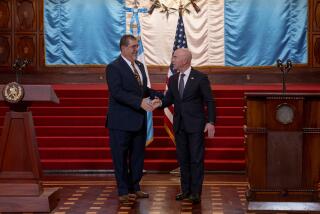Albright, on Guatemala Visit, Lauds Peace Moves
- Share via
TULULCHE, Guatemala — With scores of Indian women and children crowding near, Secretary of State Madeleine Albright stood in a remote rebel demobilization camp in western Guatemala on Sunday and hailed the success of the first phase of the peace accords ending 35 years of civil war.
“Some of you may wonder what the secretary of State is doing here,” she told the former rebels and the Indians. “We are all one family, and when one part of the family suffers, we all suffer.” She had come, she continued, to congratulate them for helping to put an end to the suffering.
It is doubtful that more than a few of the Indians understood either her English or her interpreter’s Spanish. Indians make up the majority of Guatemala’s population of 10.6 million, but they have had little opportunity to obtain formal education and speak mostly indigenous dialects.
But there is little doubt that they understood her intent, if not her words, and they applauded the arrival of an important U.S. official to bless the peace. Later Sunday, Albright arrived in Mexico City to join President Clinton for bilateral talks.
Under the peace accords--signed at the end of last year by the Guatemalan government and the umbrella guerrilla organization, the Guatemalan National Revolutionary Unity--the 3,000 rebels laid down their arms, entered eight demobilization camps and attended training programs aimed at fitting them back into civil life.
Although 500 rebels remain in the camps because they have not yet made a decision about where they want to go, the United Nations and other agencies have declared the first phase of the peace process over.
After Albright helicoptered to the Tululche camp, Jean Arnault, the chief U.N. official in Guatemala, told her that the success of the first phase was due in part to “timely, generous and well-coordinated” aid from the international community, including the U.S. Agency for International Development.
But Arnault warned that much more needs to be done in Guatemala in “modernizing the state and in attempting to bridge the social and ethnic divide.” The enormous economic and social gap between the impoverished Indian majority and the smaller mestizo and white populations in the cities has long been singled out as one of the main causes of the Guatemalan civil war.
The United States has pledged to contribute $260 million toward the $1.9 billion that a consortium of international agencies and governments intends to give the Guatemalans over the next four years.
In Latin American eyes, the embrace of the peace accords by the United States contrasts sharply with the role of the CIA in overthrowing a democratically elected Guatemalan president in 1954 and replacing him with a military government. The inept and tyrannical military governments that followed slaughtered thousands of Guatemalans while trying to put down continuous rebellions.
But that history was not recalled in the mood of congratulation at the Tululche camp.
Comandante Baltazar Zapeta, a rebel leader, explained: “There is no need to fight with guns. We are now strengthening our political arms.”
Zapeta, who had fought since 1980 and commanded 300 rebels in a unit known as the Sandino Front, spent much of his time during the Albright visit trying to instill some order and quiet among chattering Indian children. Most of the Indian women and children were either relatives of the former rebels or neighbors from nearby farms.
The head of the camp, a former rebel with the nom de guerre Comandante Randal, escorted Albright through the various facilities, including a small school for children of the rebels.
As Albright, America’s first female secretary of State, spoke, a banner fluttered nearby, proclaiming, in Spanish, “Woman is present in work, in study and in battle.”
More to Read
Sign up for Essential California
The most important California stories and recommendations in your inbox every morning.
You may occasionally receive promotional content from the Los Angeles Times.










